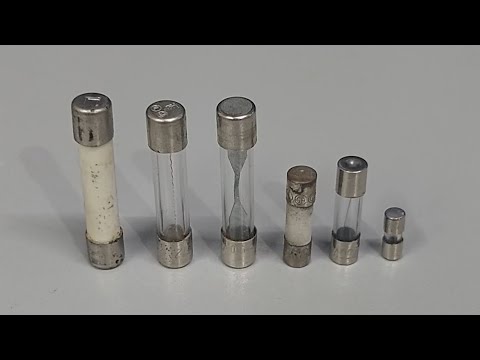Everything you need to know about the different types of cylindrical fuses
In the world of electricity, cylindrical fuses are an essential piece to guarantee the safety and correct functioning of different devices and equipment. In this article, we are going to tell you everything you need to know about the different types of cylindrical fuses: from their structure and operation, to the different applications in which they are used. Get ready to enter the fascinating world of cylindrical fuses and discover how to protect your devices efficiently!
Cylindrical fuses: essential protection for your electrical circuit
In the field of electricity, safety is paramount. This is why having cylindrical fuses in your electrical circuit is essential to protect both the components and the people who interact with them. In this article, we will explain everything you need to know about these protection devices and their importance in electrical safety.
Cylindrical fuses are devices designed to protect electrical circuits from overloads and short circuits. Its operation is based on a conductive sheet or wire that melts when the current passing through the circuit exceeds the established limit. This fusion process creates an interruption in the flow of current, thus preventing further damage to the electrical circuit.
One of the highlights of cylindrical fuses is their easy replacement. When they melt, they are simply removed from the fuse holder and replaced with a new one. This allows for quick restoration of the circuit without the need for complicated repairs. In addition, its compact size and cylindrical shape facilitate its installation in different types of circuits.
The protection capacity of cylindrical fuses is determined by their current rating, which indicates the maximum amount of current they can withstand without blowing. It is important to select the appropriate fuse according to the needs of the circuit, avoiding both under- and over-protection. Underprotection could cause damage to circuit components, while overprotection could cause false trips and affect system performance.
In addition to their primary protective function, cylindrical fuses can also indicate potential problems in the circuit. When a fuse blows repeatedly, it may be a sign that there is an ongoing overload or short circuit in the system. This allows problems to be detected and solved before they become risky situations.
Different types of fuses: Learn about all the options to protect your circuits
The protection of electrical circuits is a fundamental task to ensure safety in our homes and workplaces. One of the most common ways to protect circuits is through the use of fuses. Fuses are devices that are responsible for interrupting the flow of electrical current when an overload or short circuit occurs, thus avoiding further damage to equipment and preventing possible fires.
There are different types of fuses, each designed to protect specific circuits and comply with different safety regulations. Here are some of the most common options:
1. Glass fuses: They are the most used in domestic installations. These fuses consist of a glass tube that contains a conductive wire inside. When the electric current exceeds the set limit, the wire melts and the flow of energy is interrupted. They are easy to replace and typically have a low current rating.
2. Ceramic fuses: They are similar to glass fuses, but instead of having a glass tube, they have a ceramic tube. This makes them more resistant to heat and vibration, making them ideal for industrial and automotive applications. They are also used in high voltage circuits.
3. Cartridge fuses: These fuses come in the form of cylindrical cartridges that are inserted into a fuse holder. They can be fast-acting, meaning they melt quickly in the event of an overload, or delayed-acting, which offer greater tolerance to transient currents. They are used in industrial and commercial facilities.
4. Thermal Fuses: These fuses are mainly used in home appliances and electronic devices. They are designed to protect against overheating as they melt when the temperature exceeds a safe limit. Once it has cooled, the fuse resets automatically.
5. Semiconductor Fuses: These fuses are specifically designed to protect sensitive electronic components, such as semiconductors. They are extremely fast and melt instantly when an overload is detected. They are common in high-end electronic devices and uninterruptible power supplies (UPS).
The Basics of Fuses: A Complete Guide to How They Work and Varieties
Fuses are safety devices used to protect electrical circuits from overloads and short circuits. They are essential components in any electrical or electronic system, since their main function is to interrupt the flow of current in the event of an anomaly in the circuit.
There are different varieties of fuses, each designed to meet specific requirements. Below, we present a complete guide to the basics of fuses and their different types:
1. Cartridge fuses: They are the most common and are used in industrial and residential applications. They are composed of a glass or ceramic tube that contains a fuse element, usually made of lead-tin alloy. These fuses can be classified into two main types: fast-acting and delayed-acting. Fast-acting fuses are ideal for protecting sensitive circuits, while slow-acting fuses are more suitable for devices that require a longer time to start.
2. Automotive fuses: These are similar to cartridge fuses, but are designed specifically for use in vehicles. They are used to protect the different electrical circuits of the car, such as lights, audio systems, ignition systems, etc. These fuses usually have an amperage rating clearly indicated on their housing for easy identification and replacement.
3. Fast Acting Fuses: These fuses are used to protect sensitive circuits or electronic components that require a quick response to an overload. They are widely used in industrial, electronic and telecommunications applications. These fuses are characterized by their ability to withstand high currents for a short period of time before blowing.
4. Delayed-acting fuses: Unlike fast-acting fuses, delayed-acting fuses are designed to withstand higher currents for a longer period of time before blowing. They are ideal for protecting devices that require a longer start-up time or that have current spikes during normal operation. These fuses are commonly used in industrial and commercial applications.
5. Type D Fuses: These fuses are specifically designed to protect transformers and electric motors.
Boom! And so, dear reader, we come to the end of this amazing journey through the fascinating world of cylindrical fuses. I hope you have enjoyed discovering all the secrets and curiosities that these little devices keep as much as I did.
Now that you have all the necessary knowledge about the different types of cylindrical fuses, you can consider yourself a true expert in the field. Now you can impress your friends at the next gathering of electronics geeks!
Remember, if you ever find yourself in a situation where you need to replace a cylindrical fuse, don't panic. Simply find the right one, disconnect the power, change the fuse and voilà! Your device will come back to life like magic!
And before I say goodbye, let me remind you of one important thing: never, ever, try to replace a fuse with a toothpick or chewed gum. No, it's not a good idea. Trust me, I'm an expert.
So now, dear reader, I leave you with your new wisdom about cylindrical fuses. I hope you continue to explore the exciting world of electronics and that you are always safe from short circuits. Until the next adventure, fuse geek!




Post Comment